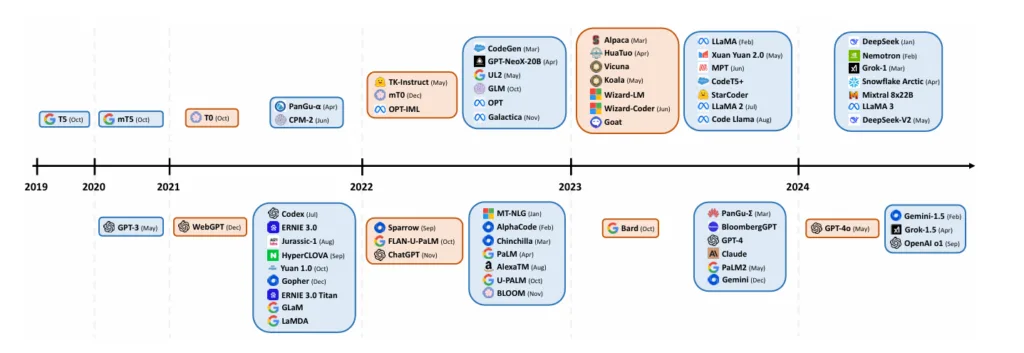
In this article, we’ll explore 11 leading open-source Large Language Models (LLMs) and how to build advanced AI workflows by integrating them with n8n and LangChain. Several models that only recently entered the list in 2024 have already secured a strong position within the n8n community.
Open-source models are reshaping the LLM landscape, offering better security, cost-efficiency, and greater customization for AI deployments. While ChatGPT boasts over 180 million users, on-premise solutions have already captured more than half of the LLM market—and are expected to continue growing in the coming years.
This trend is clear: since early 2023, the number of open-source LLMs released has nearly doubled that of closed-source models.

📆 Timeline of LLMs up to 2025
Today, we’ll dive into the world of open-source LLMs and:
-
Explore the rising wave of open-source LLM deployments;
-
Identify risks and challenges;
-
Highlight the 11 most popular open-source LLMs today;
-
Guide you on how to access these powerful models;
-
Show you how to use open-source LLMs with Ollama and LangChain in n8n.
👉 Keep reading for full details!
Are there any open-source LLMs?
Absolutely. In this article, we’ve handpicked 11 widely-used open-source LLMs, focusing on those available on Ollama.
Our review includes both base pretrained models and fine-tuned variants. These models come in various sizes—you can either use them as-is or choose pre-finetuned versions from original developers or third parties.
While base models provide a strong foundation, fine-tuned versions are often necessary for real-world or task-specific applications. Many providers offer fine-tuned versions out of the box, but users can also create their own datasets to customize models further.
🏆 Open-Source LLM Leaderboard
| Model | Developer | Parameters | Context Window | Common Use Cases | License |
|---|---|---|---|---|---|
| Llama 3 | Meta | 1B–405B | 8k–128k | General text, multilingual, code, long content, domain-specific tuning | Llama Community License |
| Mistral | Mistral AI | 3B–124B | 32k–128k | Complex tasks, multilingual, code, images, edge devices, function calling | Apache 2.0, Mistral License |
| Falcon 3 | TII | 1B–10B | 8k–32k | Text, code, math, science, multilingual, fine-tuning | TII Falcon License |
| Gemma 2 | 2B–27B | 8k | Text, Q&A, summarization, code, fine-tuning | Gemma License | |
| Phi-3.x / 4 | Microsoft | 3.8B–42B | 4k–128k | Text, multilingual, reasoning, code, image understanding | Microsoft Research License |
| Command R | Cohere | 7B–104B | 128k | Conversational AI, RAG, tool use, multilingual, long content | CC-BY-NC 4.0 |
| StableLM 2 | Stability AI | 1.6B–12B | Up to 16k | Multilingual text/code generation, task-specific fine-tuning | Stability AI Community/Enterprise |
| StarCoder2 | BigCode | 3B–15B | 16k | Code completion and understanding | Apache 2.0 |
| Yi | 01.AI | 6B–34B | 4k–200k | Bilingual text/code, math, reasoning | Apache 2.0 |
| Qwen2.5 | Alibaba | 0.5B–72B | 128k | Text, multilingual, code, structured data, math | Qwen / Apache 2.0 |
| DeepSeek-V2.x / V3 | DeepSeek AI | 16B–671B | 32k–128k | General text, multilingual, code, advanced reasoning | DeepSeek License |
For more, check out the Awesome-LLM GitHub repository with a curated list of open-source LLMs and related resources.
✅ Pros and ❌ Cons of Open-Source LLMs
✅ Advantages:
-
Full Ownership: Complete control over the model, training data, and deployment.
-
Customization Accuracy: Fine-tune precisely using your local model and community resources.
-
Long-Term Stability: No forced deprecation like proprietary APIs.
-
Cost Predictability: Shift from usage-based pricing to fixed infrastructure costs (depending on setup).
-
Hardware Flexibility: Choose your stack and optimize resources.
-
Community Contributions: Benefit from quantization, pruning, deployment strategies, and shared tools.
❌ Drawbacks:
-
Quality Inconsistency: Some open-source models may lack the polish of commercial ones.
-
Security Risks: Open environments may be vulnerable to malicious input manipulation.
-
Complex Licensing: Varies widely from permissive (Apache 2.0) to non-commercial (CC-BY-NC 4.0) to custom terms (e.g., Meta’s Llama).
What’s the “Best” Open-Source LLM?
There is no single “best” model. Evaluation depends on various metrics, which differ by research group.
Thanks to Hugging Face, a public leaderboard exists to benchmark open-source LLMs across six key metrics using Eleuther AI’s Evaluation Harness.
Anyone can submit a model for evaluation, making it an open competition. Filters include consumer-friendly, edge-device, quantized versions, etc.
🥇 Top 5 Open-Source LLMs in 2025
1. Llama 3 – Great for general-purpose apps
-
Meta’s latest model series.
-
Range from 1B to 405B parameters.
-
Supports multilingual, long-form content, and coding.
-
Strong performance at reduced cost (70B ≈ 405B).
-
Context window up to 128k tokens.
2. Mistral – Best for on-device AI & function calling
-
French startup with rapid growth.
-
MoE architecture and edge-device optimization.
-
Apache 2.0 licensing makes it highly adoptable.
3. Falcon 3 – Best for low-resource environments
-
Developed by TII (UAE).
-
Efficient on laptops and lightweight infrastructure.
-
Excellent fine-tuning support and multilingual tasks.
4. Gemma 2 – Best for responsible AI development
-
From Google, built on Gemini tech.
-
High performance with 2B–27B sizes.
-
Compatible with most major frameworks.
5. DeepSeek-V2/V3 – Best for large-scale processing
-
MoE models with up to 671B parameters.
-
High efficiency and performance.
-
MLA tech improves reasoning capabilities.
🤖 Using Open-Source LLMs with n8n
Running your own open-source LLM might sound complex—but n8n + Ollama makes it easy.
By combining the power of open-source LLMs with n8n’s automation engine, you can build powerful and customized AI apps. LangChain (JavaScript version) is the core framework to manage these LLM-powered workflows inside n8n.
You can use prebuilt nodes, or write custom JavaScript to extend their behavior.
3 Simple Ways to Use LLMs in n8n:
-
Run small Hugging Face models with a free access token.
-
Use Hugging Face’s Inference Endpoints for larger models.
-
Run local models via Ollama, either self-hosted or locally installed.
🎓 Learn via n8n Academy Templates
You can explore working AI workflow templates on the n8n Academy Template Library.
Want to learn more about n8n’s capabilities before diving in? Read this real-world review of n8n on BecomeMMO to see why it’s becoming a top choice for developers and non-tech users alike.

